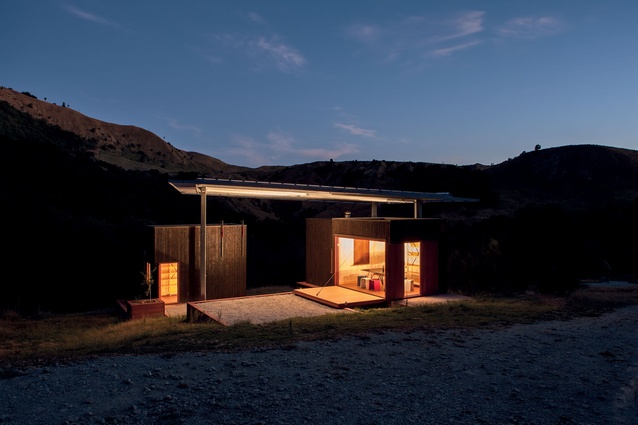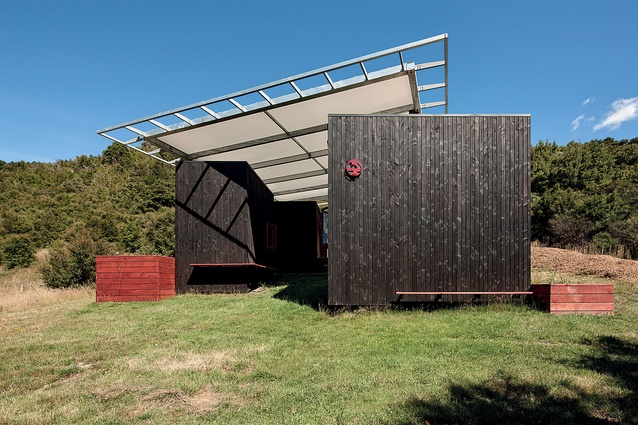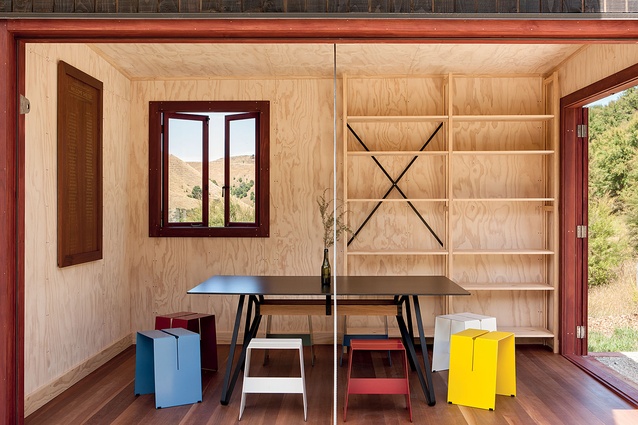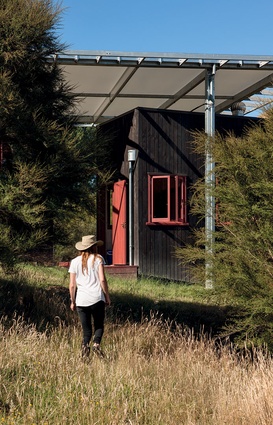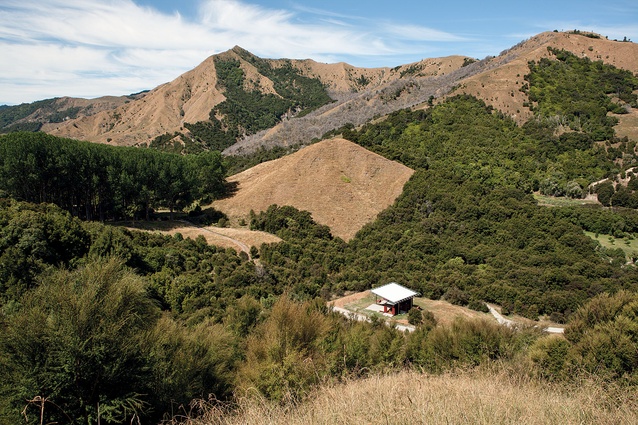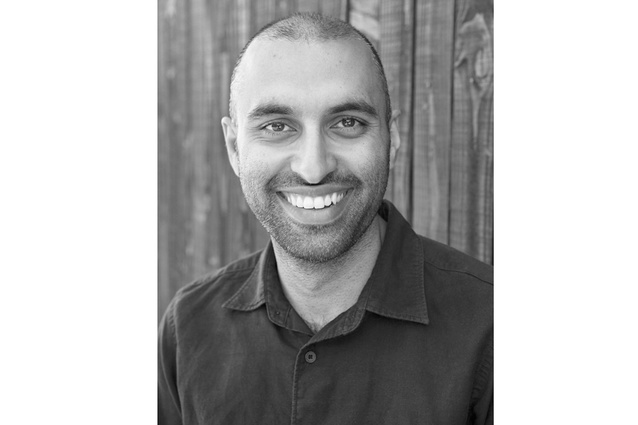Longbush Ecosanctuary Welcome Shelter
Sarosh Mulla from Sarosh Mulla Design discusses his new Welcome Shelter at Longbush Ecosanctuary, near Gisborne, with Nat Cheshire.
Nat Cheshire: Describe for us your design for the Welcome Shelter at Longbush Ecosanctuary?
Sarosh Muller: The project is an environmental education space at the Longbush Ecosanctuary, a haven for native flora and fauna just north of Gisborne, which is run by the Longbush Ecological Trust. It aims to accelerate the growth of the sanctuary, offering space for the public to learn and enjoy, while also supporting the volunteers who run it.
NC: I’m intrigued by the form and the planning. On the one hand, the scheme seems open, with this flying canopy over the top and a collection of small autonomous boxes underneath, a bit like Fumihiko Maki’s collective-form made real at a very small, rural scale – but each of those boxes is in fact very closed and there are pieces that fold and open. I couldn’t quite unpeel where that contradiction was coming from.
SM: That really comes from two opposing forces. When you visit Gisborne in the summertime, the greatest issue is that it can be sweltering, if you can’t find shade. The majority of visitors will be at the Welcome Shelter during the summer and the canopy provides them with shelter. But the volunteers will use the building throughout the year and, because the site is a north-south valley, it suffers from a blistering southerly in the winter, so, being able to enclose yourself in a warm interior during training or lunch is crucial.
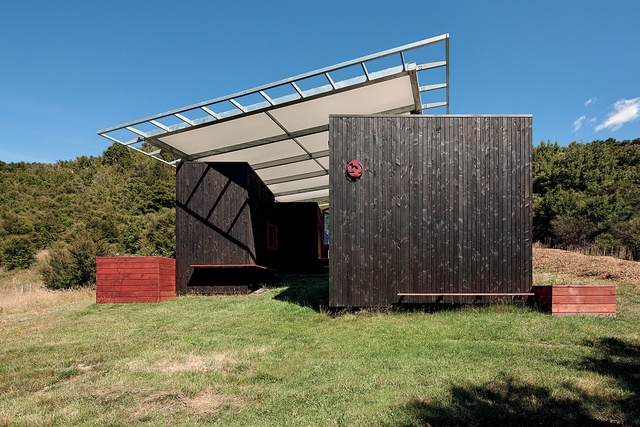
NC: We have a fairly deep vernacular of dealing with those contradictions, via the flying eave that saturates New Zealand. Firstly, there is the villa with its verandah and, latterly, pseudo-modern mono pitches with great cantilevers that deal to that contradiction. It seems here, though, that you’re being much more explicit about separating those two things. Are you trying to pull that vernacular apart, particularly given the classic Kiwi rural setting?
SM: No, I don’t think I’m trying to deal to the vernacular in that way. For the most part, the flying roof functions as that flying eave. The majority of the building is an in-between space between the external and the internal so, having places at those two poles is really important. The vernacular is something that I’m not so much trying to push against but trying to harness and amplify.
NC: What’s interesting, spatially, is that, rather than just being alongside the house and, yet, still under the shelter of its periphery, here we are between buildings and still sheltered. There’s a sense of informal encampment.
SM: The encampment is an incredibly powerful notion, particularly on the East Coast. You’re talking about one of the few parts of the country that still has freedom camping and it’s a place of great cultural freedom as well. The idea of camping, being able to gather together with minimal resources, is something that connects us to the coast in a lot of ways.
NC: In pursuing that, you’ve made life deliberately hard for yourself; I presume it’s deliberate, in that you’ve built three independent black buildings and then a separate roof, rather than just one with a lean-to or one with a verandah; it massively increases the surface area of the volumes you’re enclosing. It’s kind of anti-Buckminster Fuller, suggesting a serious commitment on the explosion.
SM: Yes, it definitely was a decision early on to go for a collection of elements rather than a singular monolithic form. I suppose we were trying to achieve humbleness in the spaces and also the idea that a larger form in that landscape wouldn’t have worked for the programme. The ecosanctuary works as a collection of people, bringing together all of their passions, interests and skills, so the building works in the same philosophy: that each of these volumes contributes something different. Doing one singular element was not the right move for us.
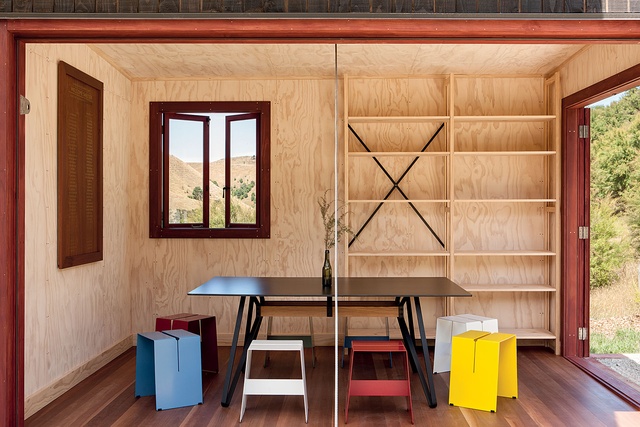
NC: There’s a strong link there with Nishizawa’s houses in Tokyo, for example, and I mentioned the Fumihiko Maki collective-form, where the programme has exploded into many parts. The rhetoric in New Zealand does not often depart from climate, client and site; are you trying to push local architecture somewhere it generally hasn’t been before?
SM: That relates more to the process of development rather than the spatial form. I took the approach very early on to create the maximum programme with minimum architecture, and to do it in a clear and accessible way, so the form is actually a very simple collection of things but the process of creating that form on zero budget was incredibly complicated.That’s very different from the vast majority of buildings in New Zealand and our sponsors haven’t seen it in the philanthropic sphere either.
NC: So how do you make architecture happen in the absence of a direct commission?
SM: A few years ago, I worked for Jeremy Salmond and we got along really well. When I went overseas, I had this idea that I would come back to Auckland and see if I could build something through a PhD and, at the same time, I was thinking about how architecture in New Zealand is used as a lens for looking at the landscape. I was talking over these ideas with Jeremy, who had been restoring the landscape at Longbush with Anne Salmond for about 10 years, and he said, “Well, maybe we could accommodate that”. So it became not so much a question of whether or not we should do this but “how?” That is quite rare, where an architect/client relationship can be collaborative and all about, “how can we get to this end goal?” rather than “what are all the things that would stop us?”
It was clear from the start that the Longbush Ecological Trust didn’t have the capital to put into a piece of architecture and raising debt to service that kind of project didn’t seem to be at all wise, so we had to devise a new development model for the typology. This is still a young part of New Zealand’s architectural history. There is just a handful of buildings around the country; obvious examples are Zealandia in Wellington – Jasmax, to its credit, really started this topology – and Tim Heath’s work at Orokonui. But the sector, as a whole, has previously run on governmental partnerships with charitable trusts. This has worked but the trusts usually take on huge amounts of debt. For Longbush, the strategy was always that we were not going to raise any debt because that would be counter to the conservation aims and would take money away from doing the actual work.
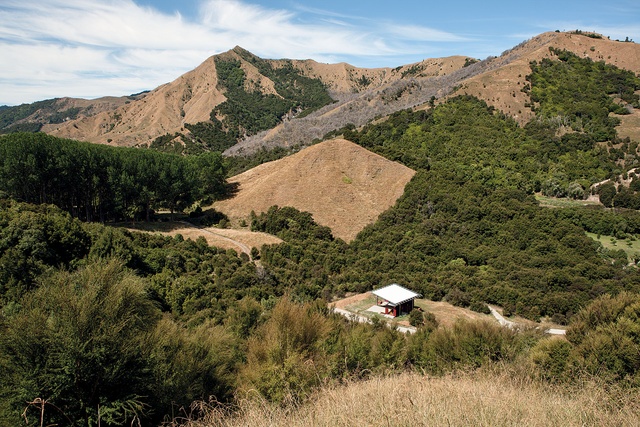
NC: It’s tangential to the discussion but Jasmax seems to have maintained a humanist bent in its practice. Ivan Mercep was perhaps the genesis of it. This is quite unusual for a firm of that size. Let’s now shift the conversation from Longbush onto you. Sean Flanagan once said of Pip (Cheshire) that he is as interested in making architects as he is in making architecture, which I thought was a lovely succinct observation; the relationship between you and Jeremy seems critical in a similar way.
When I look around my friends and a generation of young architects, there are very few - I can think only of Jessica Walker - who have roared straight out of architecture school and started their own practices. Most begin with a relationship with somebody like Jeremy, cut their teeth in their studios, and then launch out into the world with the blessing of their former mentor. It sounds like Jeremy has been incredibly important for you?
SM: He has been. I’ve been really lucky to have had lots of good mentors over the last few years: Peter Reed was an influence, and Andrew Barrie, of course, who’s supervising my PhD and has had a huge influence on the way that I practice. I suppose the thing with those relationships is that they each inject something different into your way of thinking. So, I think, that’s also a strength of this PhD by practice, that you can actually collect a huge team of advisors, which is formalising a set of those relationships. The idea of having a mentor who helps you through those first few years, of figuring out how you want to practice and how you can achieve that, is really important.
I’m hunting for the lessons in here. I remember architecture school being an incredibly bewildering time for many and, certainly, as an observation of the students that we engage with: what happens inside the school is one thing but what happens in architecture outside of it seems to almost have no relationship to that study. Is there a roadmap by which you find your way to the most adventurous and exciting engagements in architecture? Your doctoral thesis by practice is a really interesting one and, I think.
NC: There’s a presumptive poverty that goes with being a student, with no expectations of any real income or quality of life, except in the satisfactions of architecture itself. Is there a mental switch in there that has empowered you to tackle architecture in a brave and selfless way, that would be harder if you were in practice, paying PI insurance, rent, etc.
SM: I still have to pay PI insurance but, you’re right, there is a huge amount of freedom that comes from being in a programme like this. It comes from having the time to think on a topic for a sustained period; I spent three years full time doing background research on Longbush, which you wouldn’t have time to do in conventional practice.
The PhD by practice gives you the best of both worlds: practice and academia. It provides a laboratory where you can test ideas that, for various reasons, aren’t able to get off the ground in the commercial world.
NC: Yeah, I think that’s one of the important roles of a contemporary university is to act as the laboratory outside of the regular commercial pressures of the construction industry. One of the most important things is to understand what happens next. Having had that incredibly indulgent and also noble period of time in study and simultaneously in practice, what does architecture do next for you?
SM: It really solidifies the ideas that I’ve been working through. I was just thinking about whether or not the project has changed the way that I practise or think – and it hasn’t been a revolutionary change. It confirmed ideas that I already had a hunch about and I’ve found ways of doing the type of work I want to do by being innovative and flexible. I also collected a huge number of people with different backgrounds and skill sets from mine so, in terms of what happens next, it’s just bigger, better and more complex.
NC: One of our own studio’s observations, regarding the speed of change in contemporary Auckland, is that architecture increasingly will demand that kind of fluidity, responsiveness and innovation of us.
SM: Absolutely; I think architecture is heading towards a real sea change. The profession will have to continue to evolve to remain relevant and we will need to adapt our skill set to other problems. We have an incredibly important range of skills as a profession; just the ability to orchestrate a complex system is applicable to a huge range of other things. The idea that architects can add more within the society where we live is really important to me. I think the architect as cultural and community leader is something that we haven’t explored enough in the last 10 years: that we, as a group within society, are forward thinking and can see where we need to go.
NC: That’s something we’re determinedly fighting for in architecture as well but it’s an extremely exhausting and distracting fight, alongside the regular battles of making buildings. You’ve been engaged in this process of almost forcefully making architecture against its own will. Thinking back to the projects of OH.NO.SUMO, you’ve had half a decade of entirely self-created, self-funded, self-executed projects, that have manifested some burning desires on your part; in OH.NO.SUMO and on your own, you’ve sought to make architecture whether you’re invited to or not. Where does that come from?
SM: I suppose it comes from seeing the challenges in our society through architecture – trying to understand the world through architecture. There’s this classic idea that architects want to build architecture no matter what the answer to that problem really is, but we found always that what we were designing was not so much the architecture but the experience. It’s really important, through all of those projects, to try and make an immersive experience. That is not always something that comes easily and you have to try and find ways of delivering that outside the normal development models. OH.NO.SUMO really started because there was a real drive among all four of us to produce work that we were really proud of, that furthered our knowledge and that communicated to the public that architecture and design, in general, are not about a fixed outcome: it could be something unexpected and it could be fun.
NC: It seems reasonably clear that one of the great advantages of working in an environment in which you are, in one sense, the client and in the case of OH.NO.SUMO, in particular, also the contractor. In this way you are able to contradict Louis Kahn’s line about cannons: that the artist is free to make square wheels on a cannon to express the futility of war, but that architecture must make them round.
If I think about your earlier comments on the need for innovation, flexibility and responsiveness in architecture as a practice, I wonder ‘how long can this model sustain you?’ Presumably, at some point, one needs to make a crust. Have you discovered some possibility of an alternative practice of architecture that has some lineage? Following the lead of Rural Studio, for example, can you see a way to practise architecture that keeps you afloat buy which is free from the burdens that come with the conventional models of engagement?
SM: Yes, there are examples about how this model can be amplified. The Rural Studio is a seminal example, where there’s a partnership formed between the university, community organisations, individual private citizens, private funders: a huge range of people. What’s come out of this process for me is the power of collaboration and what you can achieve if you’re very particular about the kind of team that you create. For the Welcome Shelter, we gathered together an incredibly diverse and interesting team: there are 88 volunteers and another 88 sponsors and, through that huge pool, you collect all of the required expertise and resources and, as a result, you also gain the richness of all of the previous experience. In terms of moving the practice forward, it’s really about choosing projects in which you can collaborate with people who are on the cutting edge. That’s not only within the construction industry, that’s about being flexible and moving across boundaries.
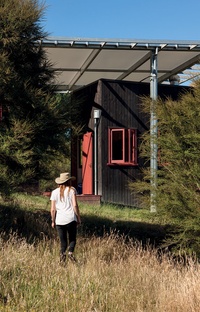
NC: It seems to me that you’ve created and tested and proved for yourself a really empowering version of the practice of architecture. It’s one that opens up all sorts of possibilities and the only thing I can’t figure out is how you pay for the cup of coffee that you’re drinking now.
SM: Well, there are lots of ways of doing that: I’m tempted to just mention the fact that Kokako coffee was one of our sponsors… but, there are lots of ways of making a crust, alongside making the architecture that you want and I, for one, refuse to believe that you can’t do both. If you want to make really good, interesting architecture that connects with people and society, then there is always going to be a way of doing that, so it’s really about trying to find all the other bits of the puzzle that fit together around it. I don’t for a second say that this is the only part of my practice, there are definitely other jobs that I take on and they all have different roles within what I’m trying to do. What’s really important though is that this is central. That this is right at the core of where the practice is heading.
NC: Do you think that the potency of New Zealand architecture in general might be amplified if its practices were to introduce little self-generative projects into their work stream?
SM: Well, selling that dream to people has been really easy when the dream is so good. It’s that old adage of sales: that the easiest thing in the world is selling someone something that’s really good. It requires no skill and so all I’m doing is telling people what we’re doing and, if that’s something they can see is worthwhile, then they join us.
NC: And what are they discovering?
SM: The team itself has come together in quite a fluid way. There are people who have been my students, architects of my generation, people who found out about the project through news media, and people who literally walked past the site and decided to give us a hand. But, once they connected with it, it was a process of them finding their place within the project. When we were on site, most of the time we all lived together on the property, which was an incredibly rich experience for me: that you can not only lead a team but you can learn so much from them throughout the day. It became this really tight family of people with really diverse life experiences. We cooked breakfast together, did a day’s labour together, which involved lunch made together, then, in the evening, we made dinner together and, then, we’d often play cards or talk about what were doing the next day or about architecture. We often talked about how architecture could be better and whether or not there was a way of creating this kind of passion for every project and I came away from it thinking that there is; you really can find this sort of passion in everything.
NC: What is the answer to that question: how can architecture be better?
SM: For me, it’s about stepping away from being the sole output and the way we communicate with the public, moving towards a more process-driven practice, where the places that we create are not only reflective of some history or vernacular forms but of the communities and the people that live within them. The parts of the Welcome Shelter that I really love are those that reflect stories from particular people; so, a ladder was made from a single piece of ma-nuka off the site by a guy called Jasper Murphy, who is a specialist green wood bodger. There is no glue or nails involved in making this ladder and it’s made without electricity. That craft doesn’t occur everywhere; it’s very particular to the person making it and to that site. There’s a history of people, craft, landscape and ecology coming together and, every time I climb up that ladder, all of those things come to me.
NC: That really interests me. One of the things that I discovered in the thick of Britomart’s most rapid transformation was that sense of community that you describe. A community beyond architecture itself is incredibly important for architecture, perhaps more so than the community of architects itself. It seemed to me that we needed to reach outside of the profession in order to make architecture as strong as it might possibly be.
However architecture, as the professional consultancy service that we had been educated in, didn’t easily allow for opportunities like this. When we were in the thick of that work downtown, so much of it was improvised; so much of it was layered and accreted from the particular energies and abilities and improvisations of the various intelligences that existed around the project - whether that was through a green wood worker like you have described, or a wonderful painter, or whatever.
The only way we got to the richest of our environments was through that kind of physical discovery, interaction and experimentation on site. We’ve discovered this to be almost impossible within the conventional architectural model of design, document, procure and administer. It seems to me that many of the richest of spatial outcomes require architecture to have some kind of greater presence or intervention in the processes of its making, and a kind of intimacy with those doing that making.
SM: I would agree with that. I think the role of singular personalities is really important but only where they are balanced with the larger goals. The role of architects within these sorts of projects is really about just orchestrating all of those forces.
NC: There’s an old maxim rolled out by generals over centuries -Colin Powell most recently - that says ‘no battle plan should survive first contact with the enemy’. I’ve always thought that to be incredibly relevant for architecture. It doesn’t deny the importance of the battle plan - an over-arching conceptual and procedural structure in which a project is to occur - but, simultaneously, it needs to allow for surprise and discovery.
SM: The surprising discovery is where all the richer stuff is and that is easiest to perceive when you’re there on the ground in your gumboots all of the time. That was really important to me at the Welcome Shelter – actually being present at the project throughout and being a consistent observer throughout. I think there’s something to be said for architects getting back into other parts of the building industry.
NC: Do you think there’s a scale or typological limit to that though? You know, I can look at Café Hanoi or the Mexico restaurants through this lens of participation, but if I think about a project that one of your OH.NO.SUMO mates Pat Loo has been involved in, the Sir Paul Reeves Building, it’s a different game altogether.
It’s a really impressive piece of architecture. In its context of multi-million-dollar heavy construction, I’m not sure those same possibilities still exist. There’s too much at stake. They are replaced with different opportunities to do with depth and planning and preparation and control and precision. Can you see and nooks and crannies and crevices in that process that might be winkled out and exploited as fields of shared improvisation? Or does it inevitably change at this bigger scale?
SM: Our role is actually to find those, so, whether or not they currently exist or not, I think is slightly irrelevant; it’s more about the fact that we should be there trying to find those opportunities. In terms of the scale limit, it definitely becomes harder but there’s also a multiplying factor where the opportunities actually become bigger as well. As challenges become bigger, the opportunities become bigger; the outcomes and all of these things slide up the scale with it. So I don’t think we should say that you can’t find richness within larger projects, I think it’s just about finding those mechanisms and that’s definitely a difficult thing to do.
NC: I can see that you’ve discovered what you love about architecture and amplified those things into a practice model that circumvents everything else… This idea of amplification is useful in a consideration of the future of architecture; it’s very good at analysing complex situations, identifying their latent potentials and exploiting those.
SM: I agree. Amplification is really a mechanism for discovery. If you can magnify the distinct parts of a problem and figure out what the constituent parts are about, then you can deal to those in new ways. I don’t think that innovation comes from stepping back and going, “Oh, that’s what’s happening”. It’s about getting into the nitty-gritty. Amplification is about how you string projects together, amplify each time and create an ongoing body of research through the work. Those themes are embedded in the Welcome Shelter and come out of OH.NO.SUMO projects, and the work I did at Simon Reed: and a number of things. So the amplification of those themes allows me to go deeper and deeper and to innovate each time.
NC: If we attack ‘amplification’ in terms of an ideology for architecture, it feels analogous to Mark Dytham’s line about having to hustle architecture into existence. Architecture often starts with a reasonably banal rationale – the endless briefs defined by almost prosaic needs. It often seems weighed down by those needs but it is the great responsibility of architecture to reach into that prosaic stuff and hustle art out of it – to turn dust into gold.
SM: You do have to hustle architecture at every scale; whether it’s a bathroom renovation or a multi-million dollar project, there’s an element of alchemy in that process. In the spirit of amplification, the one thing that I’ve discovered in the last decade or so is that alchemy, amplification and that hustling is compounding… You have to find all of those opportunities along the way and you also have to be prepared to accept that there are going to be projects which are really about delivering those bare essentials but those essentials can be delivered in a lovely way and not necessarily with more cost or more time but just with more generosity of spirit.

